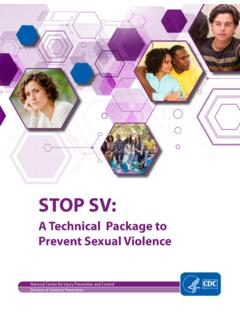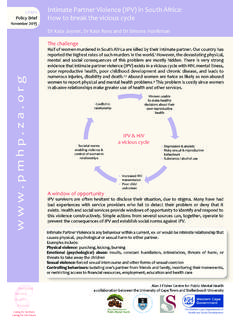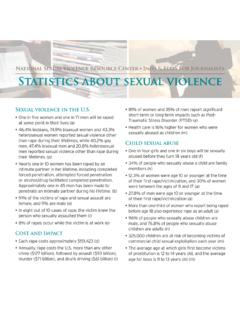Transcription of CHILD MALTREATMENT SURVEILLANCE
1 CHILD MALTREATMENT SURVEILLANCE U N I F O R M D E F I N I T I O N S F O R P U B L I C H E A LT HA N D R E C O M M E N D E D D ATA E L E M E N T SCHILD MALTREATMENT SURVEILLANCEU niform Definitions for Public Healthand Recommended Data ElementsVersion T. Leeb, PhDLeonard J. Paulozzi, MDCindi Melanson, MPHT homas R. Simon, PhDIleana Arias, PhDJanuary 2008 Centers for Disease Control and Prevention National Center for Injury Prevention and Control Atlanta, GeorgiaChild MALTREATMENT SURVEILLANCE : Uniform Definitions for Public Health and Recommended Data Elements, Version is a set of recommendations designed to promote consistent terminology and data collection related to CHILD MALTREATMENT . This document was developed through an extensive consultation process. It is published by the National Center for Injury Prevention and Control (NCIPC), part of Centers for Disease Control and Prevention (CDC).
2 Centers for Disease Control and PreventionJulie L. Gerberding, MD, MPH, DirectorCoordinating Center for Environmental Health and Injury PreventionHenry Falk, MD, MPH, DirectorNational Center for Injury Prevention and ControlIleana Arias, PhD, DirectorDivision of violence PreventionW. Rodney Hammond, PhD, DirectorSuggested citation: Leeb RT, Paulozzi L, Melanson C, Simon T, Arias I. CHILD MALTREATMENT SURVEILLANCE : Uniform Definitions for Public Health and Recommended Data Elements, Version Atlanta (GA): Centers for Disease Control and Prevention, National Center for Injury Prevention and Control; 2008. ivREVIEWERS AND PANEL MEMBERSB ernard Auchter, MSWV iolence and Victimization Research DivisionOffice of Research and EvaluationNational Institute of JusticeWashington, DCRobert W. Block, MDCommittee on CHILD Abuse and NeglectDepartment of Pediatrics, College of MedicineUniversity of Oklahoma Schusterman CenterTulsa, OKTheresa Covington, MPHM ichigan Public Health InstituteOkemos, MIMargaret Feerick, PhDNational Center on CHILD Health and Human DevelopmentRockville, MDSally Flanzer, PhDAgency for Health Care and Research QualityRockville, MDDeborah GarneauRhode Island Department of HealthProvidence, RIJohn Holton, PhDPrevent CHILD Abuse AmericaChicago, ILCarole Jenny, MD, MBAB rown Medical SchoolProvidence, RICarrie Mulford, PhDViolence and Victimization Research DivisionOffice of Research and EvaluationNational Institute of JusticeWashington, DCCatherine M.
3 Nolan, MSWA dministration for Children and FamiliesWashington, DCDomarina Oshana, PhDPrevent CHILD Abuse AmericaChicago, ILVincent J. Palusci, MD, MSMichigan State UniversityGrand Rapids, MIJon Roesler, MSMinnesota Department of HealthSt. Paul, MNPatricia Schnitzer, PhDUniversity of Missouri ColumbiaFamily and Community MedicineColumbia, MOAndrea Sedlak, PhDHuman Services Research AreaWestat, , MDSara Seifert, MPHM innesota Department of HealthSt. Paul, MNMark Van Tuinen, PhDMissouri Department of HealthJefferson City, MOWendy Verhoek-Oftedahl, PhDBrown Medical SchoolProvidence, RIStephen Wirtz, PhDCalifornia Department of Health Sacramento, CASteven YagerMichigan Family Independence AgencyLansing, MIYing-Ying Yuan, PhDWalter R. McDonald & Associates, , MDCDC Reviewers and Panel MembersKathleen Basile, PhDDivision of violence PreventionNational Center for Injury Prevention and ControlCenters for Disease Control and PreventionAtlanta, GALinda Saltzman, PhDDivision of violence PreventionNational Center for Injury Prevention and ControlCenters for Disease Control and PreventionAtlanta, GALinda Anne Valle, PhDDivision of violence PreventionNational Center for Injury Prevention and ControlCenters for Disease Control and PreventionAtlanta.
4 GAvCONTENTSR eviewers and Panel Members iiiAcknowledgements viIntroduction The Problem of CHILD MALTREATMENT 3 The Need for Consistent Definitions and Data Elements 3 The Public Health Approach to CHILD MALTREATMENT 4 CDC Development of Uniform Definitions and Recommended Data Elements 4 Development Process 5 Purpose 5 Content and Scope 6 Caveats to the Use of this Document 7 Next Steps 8 Uniform Definitions CHILD MALTREATMENT and Associated Terms CHILD MALTREATMENT 11 Acts of Commission ( CHILD Abuse) 11 Acts of Omission ( CHILD Neglect)
5 11 Caregiver 12 Harm 12 CHILD 13 Definitions of Acts of Commission ( CHILD Abuse) Physical Abuse 14 sexual Abuse 14 sexual Act 14 Abusive sexual Contact 15 Noncontact sexual Abuse 15 Psychological Abuse 16viDefinitions of Acts of Omission ( CHILD Neglect)
6 Failure to Provide 17 Failure to Supervise 18Co-occurrence of Multiple Types of Abuse and Neglect 19 Recommended Data Elements for CHILD MALTREATMENT SURVEILLANCE Introduction 23 Basic and Expanded Data Elements for CHILD MALTREATMENT SURVEILLANCE 24 CHILD Variables 26 Incident Variables 38 Physical Abuse 50 sexual Abuse 54 sexual Act(s) 57 Abusive sexual Contact 62 Noncontact sexual Abuse 66 Psychological Abuse 69 Acts of Omission ( CHILD Neglect)
7 73 Failure to Provide 74 Failure to Supervise 78 Other Incident Variables 83 Caregiver Variables 97 Household and Family Variables 114 CHILD Protective Services Complaint(s) Involving Index CHILD 122 CHILD Protective Services Complaint(s) Involving Other Children in Residence 125 References 129viiACKNOWLEDGEMENTSWe thank the experts and panel members who took time from their busy schedules to review and provide feedback on numerous drafts of this publication.
8 Their valuable input helped guide us through the lengthy development process. We also thank the staff members of CDC s National Center for Injury Prevention and Control for their contributions, especially Lawrence Barker, Kathleen Basile, Joyce McCurdy, Linda Saltzman, and Linda Anne Problem of CHILD MaltreatmentChild MALTREATMENT is a considerable social and public health problem in the United States. In 2004, data collected from CHILD Protective Services (CPS) determined approximately 900,000 children in the United States were victims of CHILD MALTREATMENT and about 1,500 children died because of abuse or neglect (US DHHS, 2006). Unfortunately, these numbers likely underestimate the number of children affected by MALTREATMENT due to underreporting and focus on a single data source. Research into the consequences of CHILD MALTREATMENT has identified various acute and severe negative outcomes such as death, injury, and traumatic brain injury.
9 Research has also uncovered many deleterious long-term developmental outcomes: academic problems, anxiety, conduct disorder, childhood aggression, delinquency, depression, increased risk for suicide, high-risk sexual behavior, interpersonal problems, poor physical health, posttraumatic stress disorder, risky health behaviors, substance abuse, and youth violence ( , Bolger, Patterson, and Kupersmidt 1998; Cerezo and Frias 1994; Felitti et al. 1998; Kang et al. 1999; Mannarino and Cohen 1996; Widom 1999). Along with the legal and medical consequences, these substantial short- and long-term sequelae make prevention, early identification, and intervention a necessity. The Need for Consistent Definitions and Data ElementsCalculation of CHILD victimization rates for MALTREATMENT depends on how the definition of MALTREATMENT is operationalized. To date, the multiple sectors addressing this issue (CPS, legal and medical communities, public health officials, researchers, practitioners, and advocates) often use their own definitions, thus limiting communication across disciplines and hampering efforts to identify, assess, track, treat, and prevent CHILD abuse and neglect effectively.
10 In addition, victimization rates are often based on reports from a single source, for example, vital statistics or CPS ( , National CHILD Abuse and Neglect Data System [NCANDS]). The most recent NCANDS estimate is per 1,000 children, or 872,000 victims per year in 2004 (US DHHS, 2006). However, the Third National Incidence Study, with its more inclusive ascertainment methods ( , multiple sources), suggests CPS may investigate fewer than half the actual number of MALTREATMENT cases (Sedlak and Broadhurst 1996). Estimates for CHILD fatalities due to MALTREATMENT vary to an even greater extent depending on the methodologies, definitions, and sources used (Crume et al. 2002; Herman-Giddens et al. 1999; McClain, Sacks, Frohlke, and Ewigman 1993). On the one hand, death certificate data from 2002 suggest rates as low as per 100,000 children 0 to 17 years of age (N = 204) (CDC Wonder website: ).
















